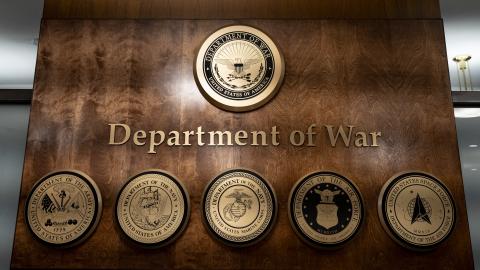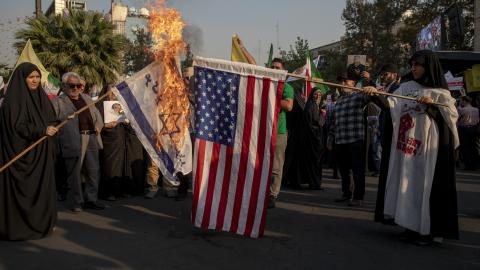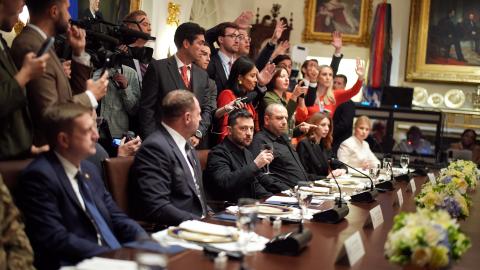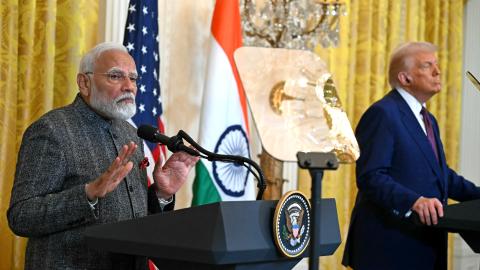On April 2, 2025, which the White House dubbed “Liberation Day,” President Donald Trump announced broad, sweeping tariffs on over 90 countries. While the president’s announcement caused anxiety in foreign capitals, officials in New Delhi remained relatively calm. United States–India relations had been improving for more than two and a half decades, and the US had become India’s largest trading partner. By most accounts, President Trump respected Prime Minister Narendra Modi—even going so far as to refer to his Indian counterpart as his “good friend.”
Furthermore, during an official visit in February 2025, President Trump and Prime Minister Modi announced a series of trade targets suggesting that a wider trade deal was imminent. The two leaders pledged to pursue $500 billion in bilateral trade by 2030—more than double the current volume—and promised to deepen US arms sales to India, including by laying the groundwork for future acquisitions of F-35 fighter jets. Prime Minister Modi committed to increasing energy imports from the US and reducing tariffs on American goods. India, by most accounts, was eager to address the Trump administration’s concerns about trade imbalances, and the two sides set fall 2025 as a target for finalizing a bilateral trade agreement.
Meanwhile, due to strong messaging from the Trump team against production based in the People’s Republic of China (PRC), Apple announced plans to shift all assembly of its US-bound iPhones to India. Prime Minister Modi also spoke with Elon Musk to discuss providing Tesla with access to Indian markets. Vice President JD Vance even visited India in late April 2025, and lauded the country’s “sense of infinite possibility.”
So, officials in New Delhi had many reasons to believe their country would emerge unscathed from President Trump’s Liberation Day.
Yet roadblocks in negotiations have tempered that initial optimism. Reporting has suggested that Indian negotiators offered their US counterparts a series of concessions over five rounds of technical talks. These included zero tariffs on industrial goods, a phased reduction of tariffs on US automobile and alcohol imports, and fixed energy and defense purchases meant to narrow the trade deficit between the two countries. In July, Indian officials left negotiations with Commerce Secretary Howard Lutnick and US Trade Representative Jamieson Greer with the impression that the two sides had agreed to a deal in principle.
However, US negotiators considered India’s offers insufficient compared to deals Washington had struck with other countries. Japan, for instance, pledged to invest $550 billion in the United States, a scale of capital commitment New Delhi could not match.
India, in turn, held firm on excluding agriculture from its negotiations with Washington. Prime Minister Modi’s government had faced immense pressure during the failed 2020–21 farm reform effort, which sparked what some believe to be one of the largest protest campaigns in history. Fearing backlash from India’s vast rural voting base, Indian officials made certain that a trade deal did not include a promise to import more agricultural products.
Amid the deadlock, President Trump took to social media, and on July 30, he issued the following ultimatum:
Remember, while India is our friend, we have, over the years, done relatively little business with them because their Tariffs are far too high, among the highest in the World, and they have the most strenuous and obnoxious non-monetary Trade Barriers of any Country. Also, they have always bought a vast majority of their military equipment from Russia, and are Russia’s largest buyer of ENERGY, along with China, at a time when everyone wants Russia to STOP THE KILLING IN UKRAINE — ALL THINGS NOT GOOD! INDIA WILL THEREFORE BE PAYING A TARIFF OF 25%, PLUS A PENALTY FOR THE ABOVE, STARTING ON AUGUST FIRST. THANK YOU FOR YOUR ATTENTION TO THIS MATTER. MAGA!
President Trump’s social media salvos continued. On July 31, he posted, “I don’t care what India does with Russia. They can take their dead economies down together, for all I care.” The president would go on to post on August 4 that the US would increase tariffs again. The Trump administration issued an executive order on August 6 clarifying that tariffs on Indian goods would reach 50 percent on August 27.
New Delhi responded defiantly. Prime Minister Modi declared that “India will never compromise on the interests of its farmers, livestock rearers and fisherfolk. And I know that I personally will have to pay a very heavy price for this, but I am ready.” Regarding Russian oil imports, India’s Ministry of External Affairs lambasted what it described as US hypocrisy, citing the United States’ and its European allies’ continued willingness to purchase Russian minerals.
Mirroring Prime Minister Modi, a press readout from Indian officials went even further: “In this background, the targeting of India is unjustified and unreasonable. Like any major economy, India will take all necessary measures to safeguard its national interests and economic security.”
The next round of trade talks was originally scheduled for August 27 but has been cancelled, and negotiations appear to be at a relative standstill. Washington’s confrontational posture has stoked post-colonialist, anti-imperialist sentiments in New Delhi, where opposition parties are eager to portray any trade concessions as signs of weakness. India has a long tradition of non-alignment, and its firm stance on Russia, long considered a key ally, has fueled a fierce news cycle.
For Prime Minister Modi, the decisions are stark. Should he concede on agricultural imports and provide investment promises to Washington, he would face a political crisis at home. Should he allow trade negotiations to collapse, he would risk losing India’s largest export destination and a key strategic partner.
Key Negotiating Issues
As negotiations continue, several issues remain paramount for both parties. Except for Russian oil, these are all long-standing issues that have been at the core of trade conversations between the two countries since the 1990s when India first opened its economy.
Agriculture. US negotiators have made clear that they expect India to reduce tariffs on meat and dairy imports and open its markets to US-made genetically modified seeds. India could open parts of this sector, but the electoral power of India’s agricultural interests renders this request difficult to concede, especially before a crucial state election this fall.
Russian Oil. Since Russia’s full-scale invasion of Ukraine in 2022, India’s imports of Russian oil, driven by discounted prices, have soared from 0.2 percent to 36 percent of its total supply. India has signaled a reluctance to end these imports, despite Washington’s past willingness to exert long-term pressure on the trading partners of oil-rich rogue states like Iran and Venezuela. Russia has offered India a further discount of 5 percent on oil purchases, but India’s foreign minister recently said that India needs to balance its trade deficit with Russia, which is increasingly due to oil imports.
Pharmaceuticals. India is the second-largest supplier of US pharmaceuticals, accounting for 47 percent of all generic medicines the US imports. While Washington is keen to impose tariffs on New Delhi, it may be reluctant to hit Indian pharmaceutical products because of how this will affect drug prices.
Intellectual Property. The Office of the US Trade Representative has criticized the Indian government for its failure to enforce intellectual property (IP) rights. Under current regulatory regimes, US officials allege that Indian companies can easily duplicate patented pharmaceuticals without consequences. New Delhi has been reluctant to allow strict enforcement of IP laws unless American companies permit increased technology transfers to India.
Market Access. Washington and New Delhi have fundamentally different attitudes toward basic market principles. India has maintained a fiercely protectionist trade posture in which discretionary licenses and tariffs are levied and removed arbitrarily. India remains largely closed to American alcohol, automobile, agricultural, and e-commerce imports, while to date Washington has imposed few reciprocal barriers on Indian goods.
The Way Forward
In his treatise Arthashastra, the ancient Indian strategist Kautilyalaid out four strategies for resolving conflicts. Each provides tools for Washington and New Delhi to resolve their current impasse.
The first is Sāma: conciliation through flattery, alliances, or diplomacy. India has largely embraced this approach, offering concessions, hosting the US vice president, and emphasizing its strategic importance in the global competition with China. However, New Delhi has not given President Trump, the central figure in these talks, the symbolic prize he appears to seek. Commentators have pointed to India’s reluctance to credit Trump for the de-escalation of tensions between New Delhi and Islamabad in May 2025 as a contributing factor to the current impasse. By publicly recognizing his role—perhaps by making largely symbolic gestures—India may be able to advance trade talks.
This path, however, would be politically fraught. Prime Minister Modi’s fragile parliamentary coalition could face backlash if last spring’s conflict with Pakistan is portrayed as anything less than a decisive victory. Indian officials have already rejected suggestions that they were pressured into a ceasefire with Islamabad. Reversing that narrative could be politically difficult.
Kautilya’s second strategy is Dāna, offering gifts or compensation. Trump clearly values high-profile investment deals. He has proudly showcased massive pledges from Gulf and East Asian nations as proof of America’s economic resurgence under his leadership. While India has not yet committed to direct investments in the US, it could reframe its defense purchases as investment promises, as several other countries have done. A multi-year, non-binding investment commitment, potentially for hundreds of billions of dollars, could help secure a favorable trade deal. A pledge to purchase US oil instead of Russian oil, even at a premium, might also serve this purpose.
However, both moves would require a willingness to risk political fallout. Such gestures could be perceived domestically as capitulations and may harm Prime Minister Modi’s political standing. They also require economic muscle that India does not yet possess, as its economy is not growing at the pace necessary for India to be able to offer such inducements.
Kautilya’s third strategy, Bheda, involves using logic or misdirection to create confusion. India could choose to exaggerate its offers or repackage existing trade commitments as major new concessions, hoping that a positive news cycle would matter more to President Trump than the actual terms of any deal. This tactic aligns with what some perceive as the president’s preference for optics and public messaging over policy details. By presenting prior agreements as fresh victories—such as defense purchases already underway, previously agreed-upon energy imports, or modest tariff reductions on low-impact goods—India might allow the White House to claim a breakthrough without making substantial changes to its own position.
Kautilya’s last strategy is Dānda, coercion or conflict. President Trump has already moved in this direction by implementing tariffs and using combative language in communications with New Delhi. Although India has largely refrained from escalating, it could retaliate by imposing its own tariffs or withdrawing from negotiations altogether. This would put existing defense agreements at risk and could threaten significant American economic interests in Indian industries and services. Such a course would be a last resort, however, and could result in a deep and lasting rupture in US-India relations that might take decades to repair.
Should negotiations fail, both sides stand to lose out on the gains they have made over the last several decades. India is the world’s most populous country and its largest democracy. It boasts the world’s fifth-largest economy and is the United States’ tenth-largest trading partner. Over the last decade, India’s gross domestic product has grown by an average of 6.81 percent per year. The US has been its largest trading partner since 2021.
As Washington works to counter China’s influence, India maintains a military larger than Russia’s, with military expenditures higher than those of South Korea and Australia combined. Walking away from closer ties with India could be a mistake the US would regret.
If cooler heads prevail, the canceled negotiations could be rescheduled to help draw both countries back from the brink. Quiet back‑channel discussions between trusted envoys may allow incremental compromises to take shape. India could signal its willingness to embrace targeted tariff reductions or to ease select non‑tariff barriers in sectors with low domestic sensitivity, while Washington might temper its demands on agricultural products in exchange for visible outcomes in other sectors. Then the two leaders could hold an in-person meeting on the sidelines of the United Nations General Assembly, where both are expected to speak in September.
Negotiations are contingent on both sides being willing to minimize public posturing and turn down the temperature. Moving forward, trade negotiators should recognize that the technical details of any agreement are only one part of making a deal palatable to President Trump. The public messaging matters, too.
Those who despair that irreparable damage to the US-India relationship has already been done should remember that President Trump is comfortable with dramatic and unexpected turns in relationships. A grand turnaround after a nosedive in negotiations would not be out of character for him. Likewise, the president’s strong preference for personal relationships with his counterparts suggests that Prime Minister Modi could directly engage with him to accelerate progress toward an agreement and put relations back on track.
There is also a pragmatic case for India to gradually lower certain market barriers and undertake sector‑specific reforms. Beyond building confidence with Washington, such measures could streamline the famously challenging business environment within the country. In parallel, the United States would do well to recognize that punitive tariffs risk the long-term alienation of a pivotal strategic partner.
If the United States and India can put their recent acrimony in the rear-view mirror, both sides stand to reap tremendous gains from a trade agreement. Unravelling relations hurt both sides—a reality that is well-known to decision-makers in Washington and New Delhi alike.
Appendix. US-India Bilateral Relationship
Table 1. US-India Trade Figures
|
|
2000 |
2024 |
|
Total Trade |
$20 billion |
$212.3 billion |
|
Trade in Goods |
$14.35 billion |
$128.9 billion |
|
Trade in Services |
$6 billion |
$83.4 billion |
|
Trade Deficit / Surplus |
Goods: $7.0193 billion Services: No specific data |
Goods: $45.8 billion Services: $102 million |
|
Trade Partner Ranking |
The US ranked first for India India ranked twenty-fifth for the US. |
The US ranked first for India. India ranked ninth for the US. |
Note: Trade partner ranking for the US is based on total trade data from June 2025, whereas India’s ranking is from the 2024–25 report by the Indian government.
Sources: Consulate General of India, Office of the US Trade Representative, The Hindu, US Bureau of Transportation Statistics, and US Census Bureau.
Table 2. Key Imports
|
From India to the United States |
From the United States to India |
|
|
2000 |
|
|
|
2024–25 |
|
|
Sources: IBEF India-US Trade, US import data, and World Bank WITS 2000.
Table 3. Foreign Direct Investment
|
From India to the United States |
From the United States to India |
|
|
2000 |
|
|
|
2024–25 |
|
|
Sources: CII 2023 report, IBEF India-US Trade, India in Atlanta report 2024, and World Bank FDI data.
Table 4. Investments in Research and Development
|
US R&D Investment in India |
Indian R&D Investment in the US |
|
|
Sources: India in Atlanta report 2024, National Science Foundation,and PIB Press Release 2022.
This report would not have been possible without the hard work and research done by the South Asia summer interns: Andrew Douglas, Srikanth Thirumalai Kumara, Souhardya De, Rai Hasen Masud, Zoha Noor, Zoya Hasan, Akshaj Bhattacharya, Hamdan Khan, Sasha Bhatia, Shreya Joshi, Christopher Rudolph, and Aarya Potti.


















